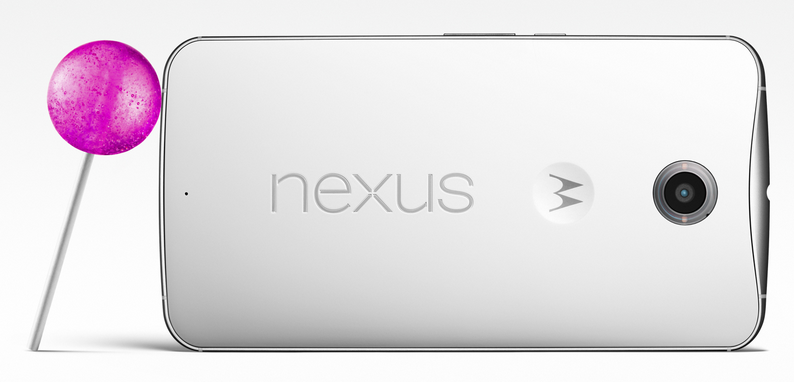New Nexus 9 tablets and Nexus 6 phones
Courtesy of Google
On Monday, the highly anticipated, flagship, Nexus 9 tablets and Nexus 6 smartphones were released. The devices run the latest Android mobile operating system, Lollipop.
Mobile retailers began selling the new, Google-powered, Nexus 9 tablet and Nexus 6 smartphone on Monday.
Both devices run the recently released Android 5.0 Lollipop operating system for mobile Android devices.
Android 5.0 includes several new features, such as improved multitasking, a modified settings and notifications center, and a newly designed interface.
Switching between editing documents, watching movies, listening to music, and browsing the web has become quicker, and fluid animations and textured shapes are now integrated directly into the design.
The tablet features an 8.9 inch LCD screen, with a 64-bit NVIDIA processor and either 16 or 32 gigabytes of memory. It comes equipped with an eight megapixel rear facing camera, and a 1.6 megapixel front facing camera.
The Nexus 9 tablet is the first Android Nexus tablet to use a 64-bit processor, and has both improved graphics and processing power compared to its predecessors. It can be found on Google Play, or in retailers such as Best Buy, Amazon, and Gamestop.
Following the industry trend of having devices with larger screen sizes, the Nexus 6 smartphone increased the size of the display to a 5.96 inch HD screen. The new flagship phone features a 13 megapixel camera, along with a quad core 2.7 GHz processor.
When the phone is low on battery, Google claims that, with only 15 minutes of charging, the phone will last for an extra 6 hours of use. On a full charge, the phone will last 24 hours. The device is also sold on Google Play, and can be found in T Mobile, AT&T, Verizon Wireless, US Cellular, and Sprint stores.
Many students prefer the operating system that powers the Nexus phones, Android, over Apple’s iOS platform. Rahul Jarayaman (12) uses a Nexus smartphone as his primary device.
“Android was the first software to have notifications; they had NFC earlier; and I feel that bigger phones are just right for my hands,” Rahul said. “Apple was pretty late to the game, and most technologies found on the iPhones of 2014 except the fingerprint scanner can be found on the Nexus line dating back to 2012.”
The Nexus lineup has typically featured phones with bigger screen sizes. With the launch of the iPhone 6 and iPhone 6 Plus, however, Apple has started to manufacture devices with screen sizes matching those of its Android competitors. From a software perspective, the Nexus devices provide users with more options for customization compared to Apple’s iOS platform.
Several students, such as Omar Hamade (11), prefer Apple devices to Android ones because they have been using Apple devices longer.
“I have been using an iPhone since freshman year and I don’t see myself being able to move on to Android-based phones. I tried using [one] and I just feel like it’s kind of different and complicated,” Omar said. “I like sticking with the Apple products and I have other Apple products, so it’s easy to keep your stuff on Apple and be able to use them across devices. I hopped onto the Apple train early on and I just don’t want to leave it.”
In addition to releasing two new mobile devices, Google released Android Wear at its annual I/O event in June. Android Wear is a software kit developers can use to build new devices including “smartwatches.”
With the release of its new Nexus devices and software platforms, Google is attempting to build a connected Android ecosystem, much like Apple has done with iOS.

Vedant Thyagaraj is the Science & Technology Editor for Harker Aquila. He is currently a senior and has been on staff for the past three years. Vedant...

Vineet Kosaraju (12) is the STEM Editor for both Harker Aquila and Winged Post. He is a senior and has been part of the journalism program for the past...


















![“[Building nerf blasters] became this outlet of creativity for me that hasn't been matched by anything else. The process [of] making a build complete to your desire is such a painstakingly difficult process, but I've had to learn from [the skills needed from] soldering to proper painting. There's so many different options for everything, if you think about it, it exists. The best part is [that] if it doesn't exist, you can build it yourself," Ishaan Parate said.](https://harkeraquila.com/wp-content/uploads/2022/08/DSC_8149-900x604.jpg)




![“When I came into high school, I was ready to be a follower. But DECA was a game changer for me. It helped me overcome my fear of public speaking, and it's played such a major role in who I've become today. To be able to successfully lead a chapter of 150 students, an officer team and be one of the upperclassmen I once really admired is something I'm [really] proud of,” Anvitha Tummala ('21) said.](https://harkeraquila.com/wp-content/uploads/2021/07/Screen-Shot-2021-07-25-at-9.50.05-AM-900x594.png)







![“I think getting up in the morning and having a sense of purpose [is exciting]. I think without a certain amount of drive, life is kind of obsolete and mundane, and I think having that every single day is what makes each day unique and kind of makes life exciting,” Neymika Jain (12) said.](https://harkeraquila.com/wp-content/uploads/2017/06/Screen-Shot-2017-06-03-at-4.54.16-PM.png)








![“My slogan is ‘slow feet, don’t eat, and I’m hungry.’ You need to run fast to get where you are–you aren't going to get those championships if you aren't fast,” Angel Cervantes (12) said. “I want to do well in school on my tests and in track and win championships for my team. I live by that, [and] I can do that anywhere: in the classroom or on the field.”](https://harkeraquila.com/wp-content/uploads/2018/06/DSC5146-900x601.jpg)
![“[Volleyball has] taught me how to fall correctly, and another thing it taught is that you don’t have to be the best at something to be good at it. If you just hit the ball in a smart way, then it still scores points and you’re good at it. You could be a background player and still make a much bigger impact on the team than you would think,” Anya Gert (’20) said.](https://harkeraquila.com/wp-content/uploads/2020/06/AnnaGert_JinTuan_HoHPhotoEdited-600x900.jpeg)

![“I'm not nearly there yet, but [my confidence has] definitely been getting better since I was pretty shy and timid coming into Harker my freshman year. I know that there's a lot of people that are really confident in what they do, and I really admire them. Everyone's so driven and that has really pushed me to kind of try to find my own place in high school and be more confident,” Alyssa Huang (’20) said.](https://harkeraquila.com/wp-content/uploads/2020/06/AlyssaHuang_EmilyChen_HoHPhoto-900x749.jpeg)



